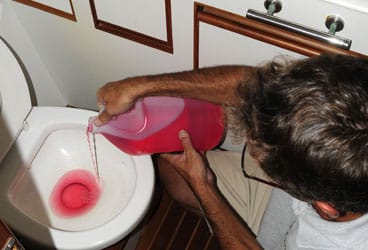
Antifreeze
There are a variety of approaches to laying up a vessel’s potable- and black-water systems. Here’s how I went about it when I managed boatyards and was responsible for winterizing hundreds of vessels.
To the greatest extent possible, empty the potable-water system. If the tank has a drain, open it and let the water run out with the aid of gravity rather than running the pump. This saves wear and tear on the motor and will flush your bilges and exercise your bilge pumps in the process. After making certain that the circuit breaker is off and tagged for layup, empty the water heater as well. Some units have a drain cock, but if yours doesn’t, simply remove the lower, cold water-in hose.
Disconnect the inlet hose to the potable-water pump and allow any remaining water to drain. Cycle the pump for a minute or so to allow it to continue to pump out any water remaining in its chambers.
If you have access to clean, oil-free compressed air (it’s what painters use when spraying), this is an ideal way to remove any remaining water from the system. Disconnect the outlet hose from the pump and apply air pressure of no more than 25 psi to the plumbing leading to the rest of the boat. Open each hot and cold faucet and allow the water to be pushed out. If you have one, don’t forget to flush the freshwater toilet.
Before adding non-toxic antifreeze to protect the tanks, fixtures, and hoses, bypass the water heater by installing a connector between its in and out hoses. Once antifreeze has entered the water heater, it’s difficult to remove the taste and smell, and it can cause foaming. For the same reasons, instead of pouring gallons and gallons of non-toxic antifreeze into the potable-water tank, allow the boat’s potable-water pump to draw antifreeze out of the containers.
Next, cover or reconnect any disconnected plumbing to prevent debris or insects from entering them during the layup. When it’s time to recommission the system, simply run fresh water through the system in the same way that you did the non-toxic antifreeze, then reconnect the tank and water-heater fittings.
Sanitation systems require their own brand of layup. Make certain that the holding tank has been pumped out. Then add fresh water to the tank and pump it out again, using the overboard discharge pump, to flush it as well. Then pour non-toxic antifreeze into the commode(s) and flush. The quantity of antifreeze depends on the length of the hose runs; if in doubt, more is better. Remember to cycle the overboard discharge pump again to fill it with non-toxic antifreeze. If the heads use raw water, then their inlets need to be disconnected from the seacocks, and non-toxic antifreeze should be drawn into the hoses. Beware: Most manufacturers of PVC sanitation hose recommend against the use of alcohol-based products, which includes non-toxic antifreeze. In this case, make every effort to purge as much antifreeze from the system as possible.
_
Steve D’Antonio offers services for boat owners and buyers through Steve D’Antonio Marine Consulting (www.stevedmarineconsulting.com)._








